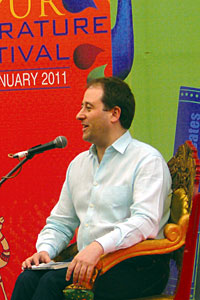 RABI THAPA |
Why do people read? A Tehelka poll from 2010 suggested that at least in India, reading is less the leisurely pursuit it is for many in the West. Even the modern Nepali may feel uncomfortable if she happens to touch a book with her feet; books are still venerated as a means to access wisdom. Reading is a part of our continuing education �" whether it is to build better business relationships, learn a language, or simply be inspired.
Biographies feature strongly in this last category in Nepal. In every book fair biographies enjoy pride of place in all stalls, and their subjects run the gamut of humanity from Gandhi to Mao. Given this strong interest, one might wonder why there are so few quality biographers working in Nepal. This week, that lack will be temporarily remedied by British writer Patrick French, who will be featuring in a session on the art of biography.
French is the author of five books, all in a sense biographies national or individual. If he was widely praised for his study of V S Naipaul, The World Is What It Is, the reactions to his latest 'intimate biography of 1.2 billion people', India: A Portrait, have been mixed (as they were for his 1997 work on that country). But then even Naipaul, seen by some as the world's greatest living writer, didn't escape censure for daring to sum up the cauldron of contradictions that makes up our giant southern neighbour.
What French brings to the art of biography is quite the opposite of the hagiographic representations of political figures Nepali readers are accustomed to. Ian Buruma has in fact credited French with pioneering the genre of the 'confessional biography'. In Naipaul's case this approach is obvious. Thanks to the subject's extraordinary candour, French is able to not only chart the writer's path to literary glory but also detail the peaks and troughs of his personal life, including the abusive nature of his relationships with his British wife and his Argentinean mistress.
But French applies the personal approach to the art of biography to entire nations, too. Combining travelogue style reportage and a long view of history, French unabashedly inserts himself into the milieux he is describing. In his 'personal history' of Tibet, for instance, the way the author comes to terms with his own 'Tibet of the mind' after surveying ground realities is central to the reader's understanding of this unfortunate country.
The intimacy of French's individual and national biographies does not distract or titillate, ultimately. Quite the contrary. By delving as deep as possible into the personal, French offers his readers the opportunity to better understand his subjects. In the case of a public figure, the confessional approach humanises the subject and grants us a fuller understanding of his life's work. With nations, the personal approach reminds us of the extent to which national representations are social and political constructions, never set in stone.
Here in Nepal we are now at a stage where we can intuitively sense the value of such an approach to individual and national biography. We are not only in the process of reviewing what our nation means and casting off monolithic notions of Nepaliness, we are also ready to discard dynastic hagiography. For the new generation of Nepali biographers and historians, French's deeply human mission may be worth pursuing. The rewards will accrue to us all.
Patrick French will be in conversation with Rabi Thapa at Ramalaya in Panipokhari Sunday 27 November, 3.30-6.30pm.


